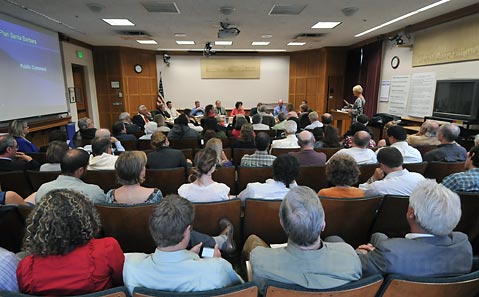Agreement over Growth
Surprising Lack of Contention over Plan Santa Barbara

There was an astonishing lack of contention at Tuesday night’s public hearing on Plan Santa Barbara, a joint session between the Santa Barbara City Council and Planning Commission on proposed revisions to the city’s fundamental blueprint for growth and development over the next 20 years. Perhaps it’s because the warring factions — traditional slow-growth neighborhood preservationists and new-urbanist smart-growthers — had duked it out over nearly three years of public workshops and planning sessions. Or perhaps it’s because the Planning Commission had already synthesized enough of what the divergent camps held near and dear into one final hybridized proposal. Whatever the explanation, there was much enthusiasm expressed for a wide-ranging menu of growth controls that would focus new density and new development in downtown Santa Barbara.
Rather than multimillion-dollar condos, however, the Planning Commission recommended that the developers be encouraged — via a combination of carrot and stick — to build more modest-sized units. Developers building rental housing would be rewarded with even higher densities. And the rules regarding approval of “granny units” should be relaxed, as well.
Giving some polarity to the proceedings was an email circulated beforehand by Councilmember Frank Hotchkiss in which he stated that any reference to climate change must be removed from the planning document. “Conclusions and proposals based on climate change have no place in the general plan update as they are speculative at best,” he wrote to planning czar Paul Casey, as well as to his fellow council members. Much of the planning document was couched in terms of promoting sustainability and in response to the prospect of global warming and climate change.
One speaker sought to remind Hotchkiss that global warming had been embraced by 2,500 scientists from 130 counties as a scientific fact, and even a speaker representing the Chamber of Commerce sought to caution new councilmembers — such as Hotchkiss — not to be alarmed by what could be construed as “green washing.” “It’s a solid document,” he said. Land-use agent Raymond Appleton testified that his client Randall Van Wolfswinkel — the Texas real estate tycoon who poured $750,000 into last November’s City Council race — was satisfied with the Planning Commission’s proposal, as well. In fact, Appleton said Van Wolfswinkel expressed regret at having spent too much, given how well the General Plan update seems to be going. How long the goodwill lasts when push comes to shove remains to be seen. Any final vote on the revised growth blueprint will require a supermajority of five councilmembers to pass. Given the stark divide among councilmembers — especially regarding transportation issues — that could prove exceptionally difficult to achieve.


